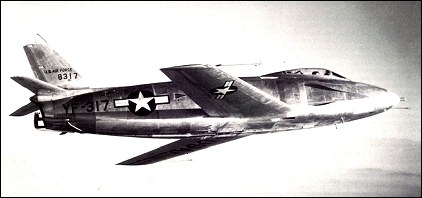|
| The North American YF-93A, developed from the F-86 Sabre and originally designated F-86C, eventually became the third design in the penetration fighter competition with the McDonnell XF-88 and Lockheed XF-90. The YF-93A was a bigger, bulkier Sabre: the nose inlet of the F-86 design was replaced with side-mounted inlets and the fuselage was widened to house a 12835kg thrust Pratt & Whitney turbojet. The result was a larger, heavier machine with longer range and greater load-carrying capacity than the Sabre. On 9 June 1948, the USAF ordered 118 F-93s, but the
order was cancelled a year later. The YF-93A lost its second chance to attain production status when it emerged a poor third in the penetration fighter contest which, as it turned out, did not result in any production contract anyway.
The first of the two YF-93As, also known as the company NA-157, was first flown on 24 January 1950. The two machines underwent various modifications during evaluation, including changes in the shape of their lateral air inlets. After the USAF was no longer a potential buyer, the two airframes were turned over to the National Advisory Committee for Aeronautics (NACA), where they were employed in various tests until eventually being retired and scrapped.
 | A three-view drawing (1280 x 822) |
| MODEL | YF-93A |
| WEIGHTS |
| Take-off weight | 12025 kg | 26511 lb |
| Empty weight | 16360 kg | 36068 lb |
| DIMENSIONS |
| Wingspan | 11.81 m | 39 ft 9 in |
| Length | 13.44 m | 44 ft 1 in |
| Height | 4.78 m | 16 ft 8 in |
| Wing area | 28.43 m2 | 306.02 sq ft |
| PERFORMANCE |
| Max. speed | 1140 km/h | 708 mph |
| Ceiling | 14265 m | 46800 ft |
| Klaatu83, e-mail, 09.12.2014 15:27 The "penetration fighter" concept was based on the WW-II scenario of long-range fighters, such as the P-51 Mustang, escorting strategic bombers to and from their targets. As updated to the post-war jet-age, the concept produced a variety of large and over-weight aircraft, not one of which proved successful. Other alternatives that were experimented with involved strategic bombers bring their own fighter escort with them, either as tine "Parasites fighters" (The McDonnell F-85 Goblin), or towed along by attaching them to the bombers' wingtips (as was tried with Republic F-84s). however, none of those concepts proved successful either. In the end, the most satisfactory solution was the development of in-flight refueling. reply | | bombardier, e-mail, 21.10.2011 11:50 That plane would have escorted the B-29s and taken care of the MiGs over Korea had it been put into production reply | | Bob Waldo, e-mail, 25.03.2010 23:33 The F93 had the Rolls Royce Tey (or Tay) engine with afterburner. The engine had a centrifugal compressor together with a flush air intake. NACA Lewis published a report showing the incompatibility between the flush intake and centrifugal compressors. Performance was badly compromised so a quick fix using a ram intake which we referred to as the Lockheed inlet after the F80. This fixed the performance but too late for the competition. During the Korean conflict I regretted the failure of the F93 to be produced as it would have made a great ground support airplane with its less vulnerable axial compressor. reply | | GARY BEDINGER, e-mail, 06.01.2010 00:04 I'VE HAD A VERY LARGE INTEREST IN MILITARY AIRCRAFT FOR MANY,MANY YEARS.THE NORTH AMERICAN YF-93 SHOULD'VE BEEN PUT INTO FULL PRODUCTION,BUT,AS WITH THE U.S.MILITARY JETS THAT WERE SO GREAT,FOR EXAMPLE THE LOCKHEED F-80 "SHOOTING STAR",THIS JET HAD MANY BUGS THAT NEEDED TO BE FULLY "STAMPED" OUT. reply | |
| | John Heron, e-mail, 12.06.2008 22:37 12835kgs (28,000lbs) from a 1950s P&W powerplant? More like 2835 kgs from the J48.
Also the weights quoted are inaccurate where the TO weight is shown to be much less than the quoted empty weight. The corrrect weights should be about 14,500lb empty and 21,000lb normal operating reply |
|
Do you have any comments?
|
| 
COMPANY
PROFILE
All the World's Rotorcraft
|







